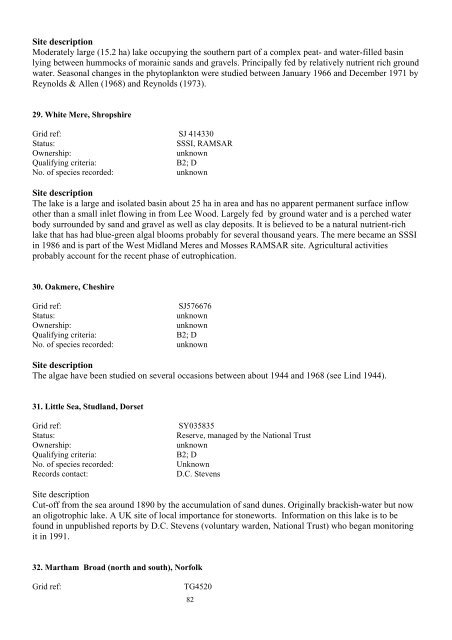Important Plant Areas for algae - Natural History Museum
Important Plant Areas for algae - Natural History Museum
Important Plant Areas for algae - Natural History Museum
You also want an ePaper? Increase the reach of your titles
YUMPU automatically turns print PDFs into web optimized ePapers that Google loves.
Site description<br />
Moderately large (15.2 ha) lake occupying the southern part of a complex peat- and water-filled basin<br />
lying between hummocks of morainic sands and gravels. Principally fed by relatively nutrient rich ground<br />
water. Seasonal changes in the phytoplankton were studied between January 1966 and December 1971 by<br />
Reynolds & Allen (1968) and Reynolds (1973).<br />
29. White Mere, Shropshire<br />
Grid ref: SJ 414330<br />
Status:<br />
SSSI, RAMSAR<br />
Ownership:<br />
unknown<br />
Qualifying criteria:<br />
B2; D<br />
No. of species recorded:<br />
unknown<br />
Site description<br />
The lake is a large and isolated basin about 25 ha in area and has no apparent permanent surface inflow<br />
other than a small inlet flowing in from Lee Wood. Largely fed by ground water and is a perched water<br />
body surrounded by sand and gravel as well as clay deposits. It is believed to be a natural nutrient-rich<br />
lake that has had blue-green algal blooms probably <strong>for</strong> several thousand years. The mere became an SSSI<br />
in 1986 and is part of the West Midland Meres and Mosses RAMSAR site. Agricultural activities<br />
probably account <strong>for</strong> the recent phase of eutrophication.<br />
30. Oakmere, Cheshire<br />
Grid ref:<br />
Status:<br />
Ownership:<br />
Qualifying criteria:<br />
No. of species recorded:<br />
SJ576676<br />
unknown<br />
unknown<br />
B2; D<br />
unknown<br />
Site description<br />
The <strong>algae</strong> have been studied on several occasions between about 1944 and 1968 (see Lind 1944).<br />
31. Little Sea, Studland, Dorset<br />
Grid ref:<br />
Status:<br />
Ownership:<br />
Qualifying criteria:<br />
No. of species recorded:<br />
Records contact:<br />
SY035835<br />
Reserve, managed by the National Trust<br />
unknown<br />
B2; D<br />
Unknown<br />
D.C. Stevens<br />
Site description<br />
Cut-off from the sea around 1890 by the accumulation of sand dunes. Originally brackish-water but now<br />
an oligotrophic lake. A UK site of local importance <strong>for</strong> stoneworts. In<strong>for</strong>mation on this lake is to be<br />
found in unpublished reports by D.C. Stevens (voluntary warden, National Trust) who began monitoring<br />
it in 1991.<br />
32. Martham Broad (north and south), Norfolk<br />
Grid ref:<br />
TG4520<br />
82

















